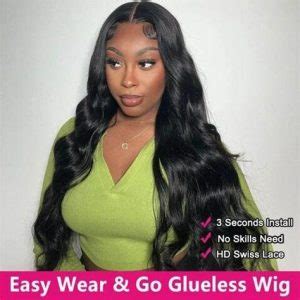Natural Hair Wigs: The Ultimate Guide
Introduction

In the world of haircare, natural hair wigs have emerged as a game-changer, offering versatility, convenience, and a seamless blend with your natural hair. This comprehensive guide will delve into every aspect of natural hair wigs, empowering you to make informed decisions and find the perfect wig for your individual needs.
Chapter 1: The Anatomy of a Natural Hair Wig
- Construction: Wigs can be made with various bases, such as lace, mesh, or silk, each with unique advantages and disadvantages.
- Hair Type: Natural hair wigs are crafted from human hair, providing unparalleled realism and durability.
- Density: The density of the wig refers to the amount of hair per square inch, ranging from light to extra heavy.
- Length and Texture: Choose from a wide range of lengths and textures to match your natural hair or explore new styles.
Chapter 2: Benefits and Drawbacks of Natural Hair Wigs
Benefits:
- Versatility: Wigs allow for instant hair transformations, giving you the freedom to switch up your look without damaging your own hair.
- Protection: Wigs can protect your natural hair from heat styling, harsh chemicals, and environmental damage.
- Convenience: Wigs save time on styling and maintenance, allowing you to look your best with minimal effort.
- Confidence: A well-chosen wig can boost your confidence and enhance your overall appearance.
Drawbacks:
- Cost: Natural hair wigs can be more expensive than synthetic wigs.
- Maintenance: Wigs require regular care, including washing, conditioning, and styling.
- Authenticity: Some wigs may not perfectly match your natural hair texture or color.
- Lifespan: Natural hair wigs have a shorter lifespan than synthetic wigs, typically lasting 6-12 months with proper care.
Chapter 3: Types of Natural Hair Wigs
- Full Lace Wigs: These wigs feature a full lace cap that creates a natural hairline and allows for versatile styling options.
- Lace Front Wigs: These wigs have a lace front that mimics a natural hairline, providing a more realistic appearance than traditional wigs.
- Closure Wigs: Closure wigs have a small lace or silk closure at the top of the head, providing a natural part and reducing the need for glue or tape.
- Clip-In Wigs: These wigs are attached to your hair using clips, allowing for easy removal and versatility.
Chapter 4: How to Choose the Perfect Natural Hair Wig
- Consider Your Hair: Determine the length, texture, and color of your natural hair to find a wig that complements your own hair.
- Set a Budget: Natural hair wigs range in price, so establish a realistic budget before you start shopping.
- Visit a Salon: A professional hairstylist can help you determine the best type and style of wig for your individual needs.
- Read Reviews: Research different wig brands and read reviews from other customers to get an idea of their quality and authenticity.
Chapter 5: Care and Maintenance of Natural Hair Wigs
- Washing: Wash your wig regularly with sulfate-free products designed for human hair.
- Conditioning: Condition your wig after each wash to keep it soft and manageable.
- Styling: Use heat protectant spray when styling your wig with heat tools.
- Storage: Store your wig on a wig stand or in a ventilated container when not in use.
Chapter 6: Frequently Asked Questions
- Can I dye natural hair wigs? Yes, but it’s recommended to consult a professional hairstylist to avoid damaging the wig.
- How long do natural hair wigs last? With proper care, natural hair wigs can last 6-12 months.
- Are natural hair wigs comfortable to wear? Yes, most natural hair wigs are designed to be lightweight and breathable.
- Can I swim in a natural hair wig? It’s not recommended, as chlorine and saltwater can damage the hair.
Chapter 7: Creative New Applications of Natural Hair Wigs
Beyond Traditional Use:
- Hair Extensions: Add length, volume, or color to your own hair without the commitment of permanent extensions.
- Cosmetics: Create realistic hair accessories and props for makeup and fashion shoots.
- Movie Making: Design custom hairpieces and wigs for film and television productions.
- Educational Tools: Demonstrate hair styling techniques to students or clients using natural hair wigs.
Conclusion
Natural hair wigs offer countless benefits, from versatility and convenience to protection and confidence enhancement. By understanding the anatomy, types, benefits, and care requirements, you can find the perfect wig to suit your individual style and needs. Remember, wigs are not just for changing your look; they are a valuable tool for self-expression, hair protection, and creative exploration.
